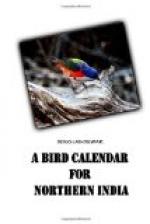The activity of the feathered folk is not at its height in January. Birds are warm-blooded creatures and they love not the cold. Comparatively few of them are in song, and still fewer nest, at this season.
Song and sound are expressions of energy. Birds have more vitality, more life in them than has any other class of organism. They are, therefore, the most noisy of beings.
Many of the calls of birds are purposeful, being used to express pleasure or anger, or to apprise members of a flock of one another’s presence. Others appear to serve no useful end. These are simply the outpourings of superfluous energy, the expressions of the supreme happiness that perfect health engenders. Since the vigour of birds is greatest at the nesting season, it follows that that is the time when they are most vociferous. Some birds sing only at the breeding season, while others emit their cries at all times. Hence the avian choir in India, as in all other countries, is composed of two sets of vocalists—those who perform throughout the year, “the musicians of all times and places,” and those who join the chorus only for a few weeks or months. The calls of the former class go far to create for India its characteristic atmosphere. To enumerate all such bird calls would be wearisome. For the purposes of this calendar it is necessary to describe only the common daily cries—the sounds that at all times and all seasons form the basis of the avian chorus.
From early dawn till nightfall the welkin rings with the harsh caw of the house-crow, the deeper note of the black crow or corby, the tinkling music of the bulbuls, the cheery keky, keky, kek, kek ... chur, chur, kok, kok, kok of the myna, the monotonous cuckoo-coo-coo of the spotted dove (Turtur suratensis), the soft subdued cuk-cuk-coo-coo-coo of the little brown dove (T. cambayensis), the mechanical ku-ku—ku of the ring-dove (T. risorius), the loud penetrating shrieks of the green parrot, the trumpet-like calls of the saras crane, the high-pitched did-he-do-it of the red-wattled lapwing, the wailing trill chee-hee-hee-hee hee—hee of the kite, the hard grating notes and the metallic coch-lee, coch-lee of the tree-pie; the sharp towee, towee, towee of the tailor-bird, the soft melodious cheeping calls of the flocks of little white-eyes, the chit, chit, chitter of the sparrow, the screaming cries of the golden-backed woodpecker, the screams and the trills of the white-breasted kingfisher, the curious harsh clamour of the cuckoo-shrike, and, last but by no means least, the sweet and cheerful whistling refrain of the fan-tail flycatcher, which at frequent intervals emanates from a tree in the garden or the mango tope. Nor is the bird choir altogether hushed during the hours of darkness. Throughout the year, more especially on moonlit nights, the shrieking kucha, kwachee, kwachee, kwachee, kwachee of the little spotted owlet disturbs the silences of the moon. Few nights pass on which the dusky horned owl fails to utter his grunting hoot, or the jungle owlet to emit his curious but not unpleasant turtuck, turtuck, turtuck, turtuck, turtuck, tukatu, chatuckatuckatuck.




